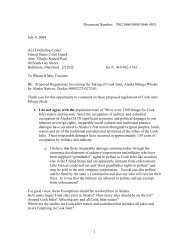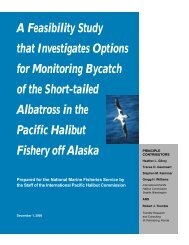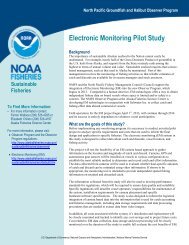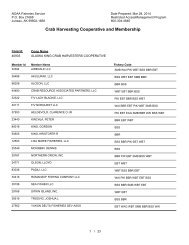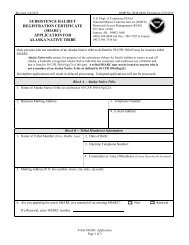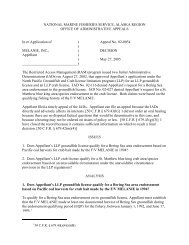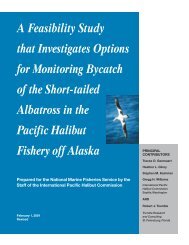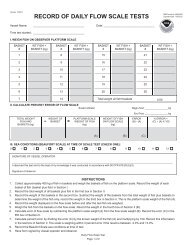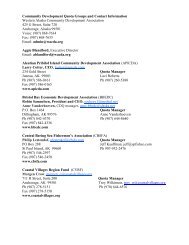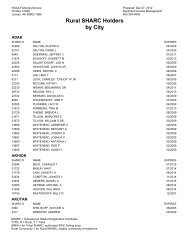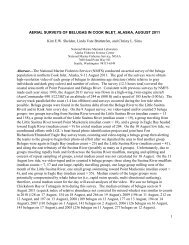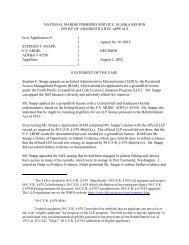Petition to List Lynn Canal Pacific Herring under the Endangered ...
Petition to List Lynn Canal Pacific Herring under the Endangered ...
Petition to List Lynn Canal Pacific Herring under the Endangered ...
You also want an ePaper? Increase the reach of your titles
YUMPU automatically turns print PDFs into web optimized ePapers that Google loves.
2. Juneau Access Improvement Project<br />
The proposed construction of a major highway from Juneau <strong>to</strong> Skagway by <strong>the</strong><br />
State of Alaska and <strong>the</strong> Federal Highway Administration threatens some of <strong>the</strong> last<br />
remaining spawning areas for <strong>Lynn</strong> <strong>Canal</strong> <strong>Herring</strong>. The Juneau Access Improvements<br />
Project (JAIP) is planned <strong>to</strong> cut along <strong>the</strong> coastline on <strong>the</strong> eastern shore of Berners Bay<br />
(FHWA 2006a, 2006b). Increased runoff and access will degrade <strong>the</strong> spawning beds.<br />
The Final Environmental Impact Statement (FEIS) for <strong>the</strong> Juneau Access Improvement<br />
Project indicates that <strong>Lynn</strong> <strong>Canal</strong> <strong>Pacific</strong> <strong>Herring</strong> are a primary concern and an<br />
“unresolved issue.”<br />
NMFS, EPA, and OHMP have expressed concern that <strong>the</strong> cumulative marine<br />
traffic in Berners Bay associated with Alternatives 3, 4B, and 4D in conjunction<br />
with Kensing<strong>to</strong>n Mine and Goldbelt activities could have an adverse effect on <strong>the</strong><br />
<strong>Lynn</strong> <strong>Canal</strong> herring s<strong>to</strong>ck. Both NMFS and OHMP believe special conservation<br />
measures, including no operations during <strong>the</strong> herring spawning period, would be<br />
necessary.<br />
(FHWA 2006a: S-18)<br />
The Record of Decision for <strong>the</strong> JAIP selects Alternative 2B (FHWA 2006b). This<br />
alternative will consist of a 50.8-mile long highway from <strong>the</strong> end of Glacier Highway at<br />
Echo Cove <strong>to</strong> a point north of <strong>the</strong> Katzehin River delta. A new ferry terminal will be<br />
constructed at <strong>the</strong> nor<strong>the</strong>rn end of <strong>the</strong> new highway, with shuttle ferry service <strong>to</strong> both<br />
Skagway and Haines from <strong>the</strong> new terminal (FHWA 2006b). A <strong>to</strong>tal of approximately<br />
36 acres of intertidal and subtidal marine habitat will be filled or dredged for construction<br />
of Alternative 2B (FHWA 2006b).<br />
The impact of <strong>the</strong> road project on <strong>Lynn</strong> <strong>Canal</strong> <strong>Herring</strong> was analyzed in <strong>the</strong> FEIS,<br />
but highway and shoreline developments are cited as only one fac<strong>to</strong>r in <strong>the</strong> decline of <strong>the</strong><br />
herring. Use this cumulative threats argument, <strong>the</strong> JAIP FEIS discounts <strong>the</strong> negative<br />
effects of <strong>the</strong> proposed highway.<br />
Comment: The highway would lead <strong>to</strong> herring die off in Berners Bay similar <strong>to</strong><br />
what occurred with <strong>the</strong> Auke Bay herring fishery. This would result in a collapse<br />
<strong>to</strong> <strong>the</strong> food-web.<br />
Response: The EFH Assessment (Appendix N of <strong>the</strong> Final EIS) discusses <strong>the</strong><br />
possible causes of <strong>the</strong> decline of <strong>the</strong> Auke Bay herring fishery in relation <strong>to</strong> <strong>the</strong><br />
potential for similar impacts in Berners Bay from highway and/or ferry terminal<br />
construction and operation. While <strong>the</strong> cause of <strong>the</strong> Auke Bay herring decline is<br />
unknown, <strong>the</strong> most likely fac<strong>to</strong>rs are loss of spawning habitat and overfishing.<br />
Alternative 2B would not involve any construction below <strong>the</strong> high tide line<br />
adjacent <strong>to</strong> herring habitat, and in <strong>the</strong>se locations a vegetated upland buffer will<br />
be retained. Also, because most of <strong>the</strong> land adjacent <strong>to</strong> Berners Bay herring<br />
spawning habitat is <strong>under</strong> a USFS management plan that does not allow<br />
47



